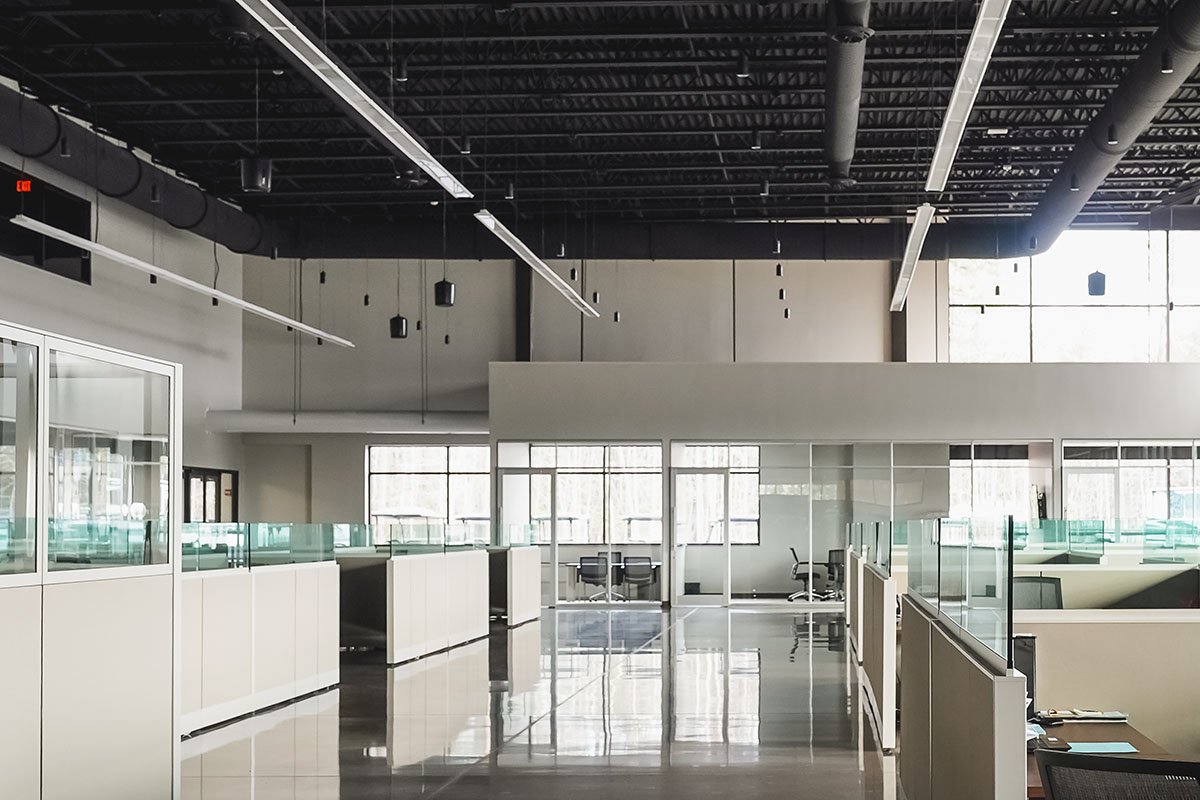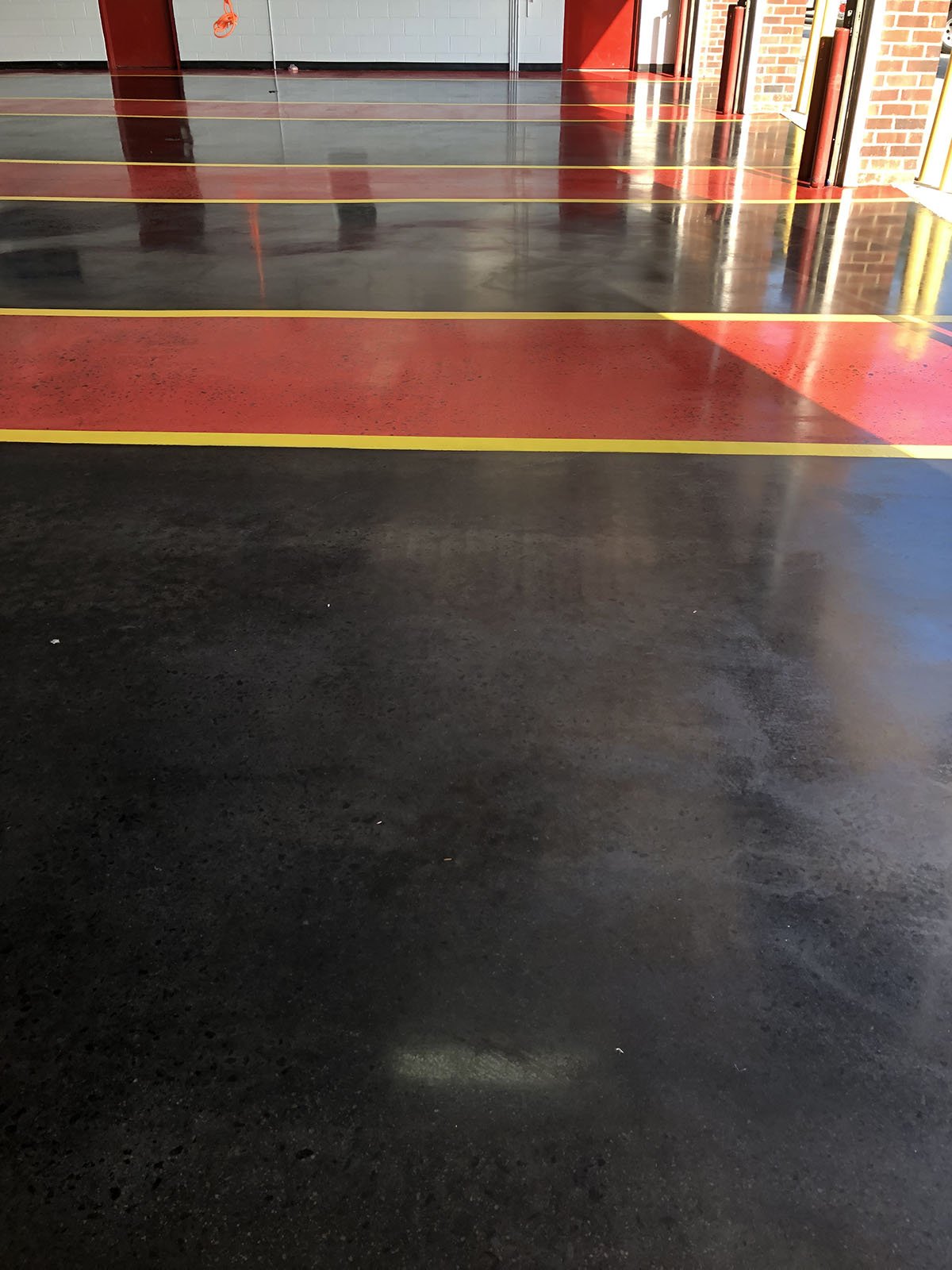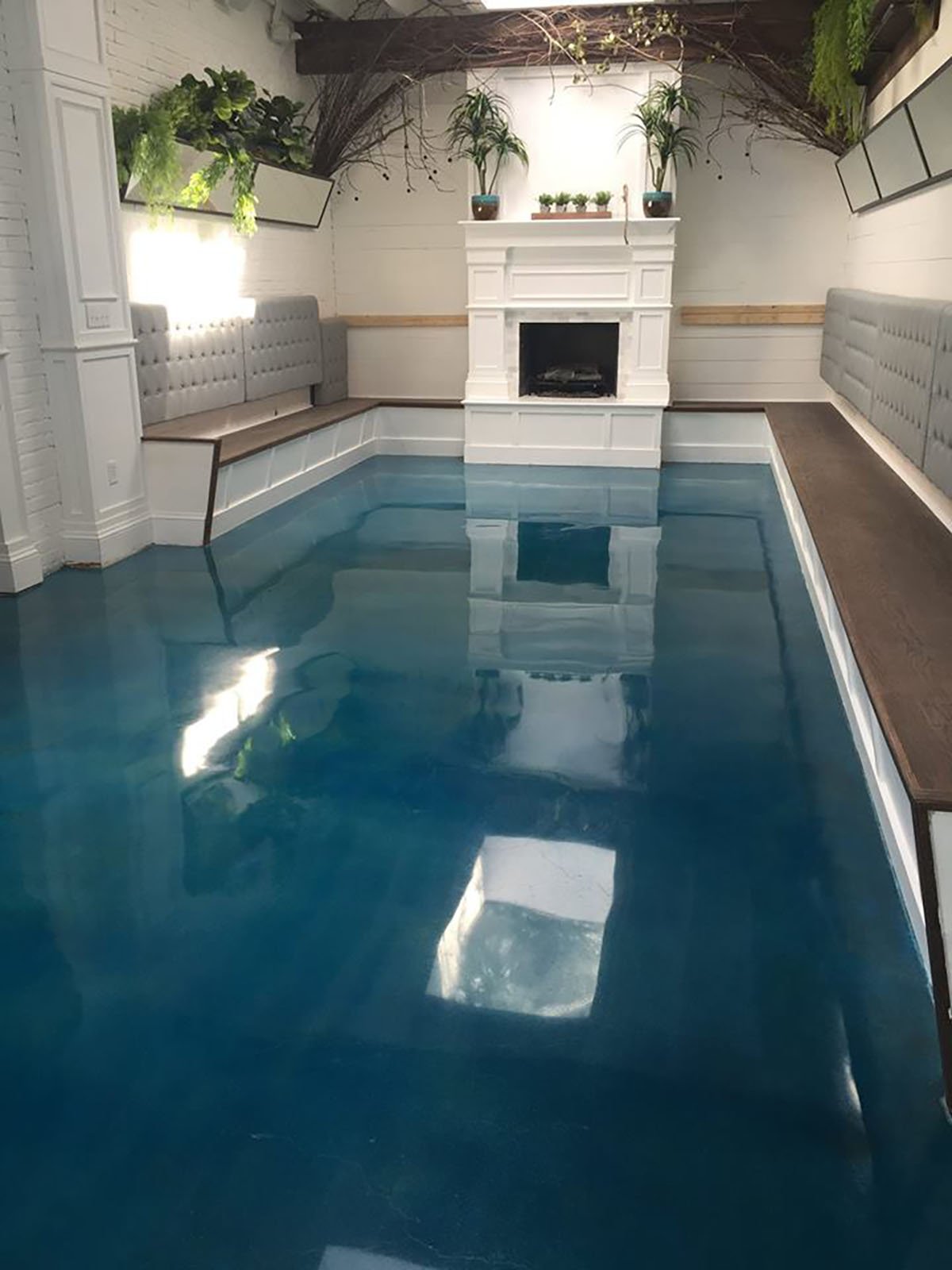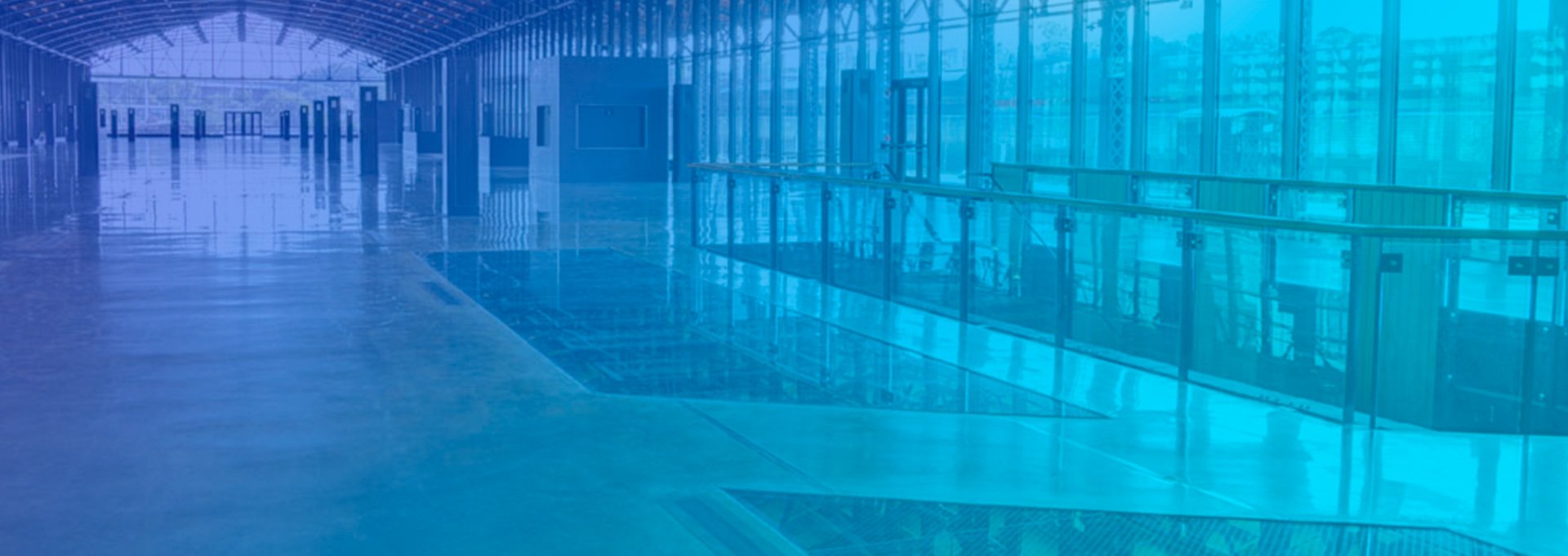INNOVATIVE AND ECONOMICAL FLOORING OPTIONS
Polished Concrete

What is Polished Concrete?
Polished concrete is a mechanical grinding & polishing process that utilizes industrial diamonds & impregnating hardeners and sealers to level, densify, polish & finally seal the floor from within the interior of the floor surface.
Polished concrete is one of the most innovative and economical flooring options available today, and its popularity is leading the flooring market in warehouse, retail, and decorative facilities across the nation. From showrooms to industrial plants, government buildings to retail facilities, polished concrete is quickly becoming one of the fastest growing, most versatile flooring solutions in the industry.
There is nothing more powerful than seeing the transformation of polished concrete in person, which is why we offer mobilized demonstrations to show you what it can do for your facility. Just pick out your worst, highest traffic area and prepare to be amazed.
A long-lasting and eco-friendly solution
Terrazzo Polishing
Benefits
Cementitious Terrazzo can readily be densified and polished to a fine finish. Plus, polished Terrazzo eliminates the need for tedious and expensive maintenance. There’s no longer a need to strip and rewax the floor every year.
By eliminating the need for harsh chemicals, our flooring provides a long-lasting and eco-friendly solution for a finish that will certainly help meet and provide LEED credit considerations.
Whether you’re looking to restore a terrazzo floor or place a new one, we can help. That means we handle every aspect of installation and restoration including:
No matter the reason or need, we have the capability to make your terrazzo floor look new again. This includes historic renovations, dullness from foot traffic and much more.
Chip & Crack Repair
What was once a gray ugly fill today is an artfully prepared blend of stone and resin designed to match your existing floor construction. We handle everything:
Chip Size
Marble chips are size graded to match the original chips
Chip Distribution
Mix of chips is analyzed and determined to insure the repair blends
Chip Type & Color
Stone type and color is graded and matched
Matrix Color
Color of the base portland or epoxy is analyzed and a comparable colored resin is formulated to minimize color difference.
Fully Custom Concrete Furnishings
Custom Engraving & Permanent Markings

Concrete home furnishings are showing up in all the top design magazines. A designer friendly product, concrete furnishings are not restricted to standard shapes or sizes.
Our concrete furnishings are fully custom. Molded and cast in our studio, each project is unique and fit to its specific requirements. These pieces have an unlimited number of color, edge and finish combinations.
The process begins with the creation of a 3D model of the project. Using the model, you will be able to truly see the design and make modifications prior to creation.
Transform Your Floors
Concrete Stain
Staining concrete is one of the most popular applications for transforming concrete slabs. Often referred to as colored concrete, homeowners, designers and builders are drawn to stained concrete because of the unique outcome that can be achieved combining colors, application techniques, etc., on cement flooring and other substrates. The results are limited only by the creativity of those involved in the stained concrete process.
Advantages of Stained Concrete
Among their many benefits, stained concrete floors are:
Remember that dyes will not mask or hide imperfections in the floor and may appear different in areas that have received different pours or patches.
We Use Ameripolish® Dye Classic
The Ameripolish® solvent base dye is formulated using extremely fine molecules of color designed to penetrate and color any cementitious surface. Ameripolish® dye was created for use with polished concrete, but can also be used as a base color or touch up for concrete that has received integral color, dry shake hardeners, acid stains or even as an overlay to itself.
Ameripolish® solvent-based dye is packaged in powder form to be mixed with acetone and the Penetrating Agent by the customer. Ameripolish® dye has 24 standard colors. Dye colors can be combined to create an unlimited number of color variations.
The most important step of any flooring application
Surface Preparation
Surface preparation is considered to be the most important step of any flooring application. Improper surface preparation could turn what seems to be a simple process into a lengthy difficult repair.
Choosing a Method:
Surface Prep Methods:
Shaving, Grinding, Polishing, Shot Blasting
Shaving
The ShaveMaster™ is a specially designed floor machine that makes coatings removal and concrete corrections simple. It creates a series of evenly spaced grooves that can also be used to provide traction and reduce the risk of slips and falls. The ShaveMaster™ uses diamond blades to create a precise pattern. Unlike scarifying or shot blasting, safety grooving leaves the floor structure intact and provides a long lasting, uniform appearance.
Applications:
-
- Aggregate exposure
- Improve floor flatness
- Paint striping removal
- Correct a poorly placed concrete slab
- Remove spalled areas or failing slurry caps
Polishing
Concrete polishing is achieved by using heavy-duty polishing machines equipped with progressively finer grits of diamond-impregnated segments or disks (akin to sandpaper) are used to gradually grind down surfaces to the desired degree of shine and smoothness.
The process begins with the use of coarse diamond segments bonded in a metallic matrix. These segments are coarse enough to remove minor pits, blemishes, stains, or light coatings from the floor in preparation for final smoothing. Depending on the condition of the concrete, this initial rough grinding is generally a three- to four-step process.
Concrete polishing is a great solution to problem floor conditions such as moisture, chemicals or hard abuse.
Grinding
Diamond grinding is typically used to level uneven pavement and to roughen surfaces for skid resistance. It has low dust levels, removes epoxies and urethanes but is slower than other methods. Some diamond grinders can also leave swirl marks in the slab if you’re overly aggressive.
Some of the advantages of a diamond ground pavements include:
Shot Blasting
Steel Shot Blasting is the preferred method of mechanical preparation that cleans and profiles simultaneously. Shot Blasting strips thin coatings, removes contamination and laitance (soft concrete) to reveal a mechanical profile for improved bonding. This method is achieved by blasting a concrete surface with steel shot (small steel balls) at a high velocity. It is suitable for large and small areas. Shot Blasting delivers high production rates, dust free, dry and cost-effective. Excess shot must be swept-up after blasting and dust is recovered by a powerful dust collection system.
Joints can be repaired to prevent the spread of damage
Joint Repair
Concrete expansion joints are placed in concrete slabs in order to allow for trouble-free expansion and contraction of the concrete during temperature changes. By placing expansion joints when laying concrete, you prevent the cracks and breaks that may otherwise occur in the concrete if the safety margin of the joints were not added. Unfortunately, either through a mistake when cutting the joints, or simply with the passage of time, these joints may become damaged. When the joints have grown wide over time, pulled away from adjoining structures, or developed cracks, the joints can be repaired using a joint sealer, preventing the spread of damage to the rest of the concrete, or the adjoining structure.
During the first stages of settling, concrete tends to shrink in volume. This shrinkage can cause surfaces to become unstable and cracks to form around the building’s most structurally weak areas — most notably the joints.
Joints exist where one concrete slab meets another, and usually require the most ongoing maintenance. Their edges often become damaged as a result of the high amount of traffic they experience on a daily basis.
The cracks that form on these joints, if ignored, can lead to further structural weakness, and eventually to crumbling concrete.
Concrete floor joints are designed and positioned to allow movement in concrete floors, without restraining movement as that could lead to random cracking. Joint sealant should be rigid enough to provide support and protection to the concrete arrisses, but it must also accommodate the anticipated movement in the floor whilst remaining bonded to at least one face of the joint.
The four steps that must be followed to repair joint damage include:


